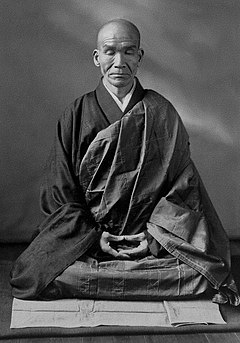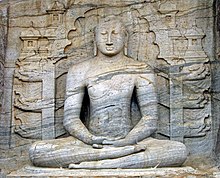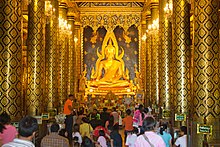Common Buddhist practices
Hearing and learning the Dharma
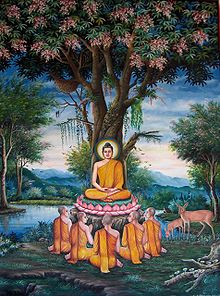
Sermon in the Deer Park depicted at Wat Chedi Liem-Kay
In various suttas which present the graduated path taught by the Buddha, such as the
Samaññaphala Sutta and the
Cula-Hatthipadopama Sutta, the first step on the path is hearing the Buddha teach the Dharma.
[210] This then said to lead to the acquiring of confidence or faith in the Buddha's teachings.
[210]Mahayana Buddhist teachers such as
Yin Shun also state that hearing the Dharma and study of the Buddhist discourses is necessary "if one wants to learn and practice the Buddha Dharma."
[257] Likewise, in Indo-Tibetan Buddhism, the "Stages of the Path" (
Lamrim) texts generally place the activity of listening to the Buddhist teachings as an important early practice.
[258]Refuge
Traditionally, the first step in most Buddhist schools requires taking of the "Three Refuges", also called the Three Jewels (
Sanskrit:
triratna,
Pali:
tiratana) as the foundation of one's religious practice. This practice may have been influenced by the
Brahmanical motif of the triple refuge, found in the
Rigveda 9.97.47,
Rigveda 6.46.9 and
Chandogya Upanishad 2.22.3–4. Tibetan Buddhism sometimes adds a fourth refuge, in the
lama. The three refuges are believed by Buddhists to be protective and a form of reverence.
The ancient formula which is repeated for taking refuge affirms that "I go to the Buddha as refuge, I go to the Dhamma as refuge, I go to the Sangha as refuge."
[261] Reciting the three refuges, according to Harvey, is considered not as a place to hide, rather a thought that "purifies, uplifts and strengthens the heart".
Śīla – Buddhist ethics

Buddhist monks collect alms in Si Phan Don,
Laos. Giving is a key virtue in Buddhism.
Śīla (Sanskrit) or sīla (Pāli) is the concept of "moral virtues", that is the second group and an integral part of the Noble Eightfold Path. It generally consists of right speech, right action and right livelihood.
One of the most basic forms of ethics in Buddhism is the taking of "precepts". This includes the Five Precepts for laypeople, Eight or Ten Precepts for monastic life, as well as rules of Dhamma (
Vinaya or
Patimokkha) adopted by a monastery.
[262]Precepts
Buddhist scriptures explain the five precepts (
Pali:
pañcasīla;
Sanskrit:
pañcaśīla) as the minimal standard of Buddhist morality. It is the most important system of morality in Buddhism, together with the
monastic rules.
[265]The five precepts are seen as a basic training applicable to all Buddhists. They are:
[262][266][267]- "I undertake the training-precept (sikkha-padam) to abstain from onslaught on breathing beings." This includes ordering or causing someone else to kill. The Pali suttas also say one should not "approve of others killing" and that one should be "scrupulous, compassionate, trembling for the welfare of all living beings."[268]
- "I undertake the training-precept to abstain from taking what is not given." According to Harvey, this also covers fraud, cheating, forgery as well as "falsely denying that one is in debt to someone."[269]
- "I undertake the training-precept to abstain from misconduct concerning sense-pleasures." This generally refers to adultery, as well as rape and incest. It also applies to sex with those who are legally under the protection of a guardian. It is also interpreted in different ways in the varying Buddhist cultures.[270]
- "I undertake the training-precept to abstain from false speech." According to Harvey this includes "any form of lying, deception or exaggeration...even non-verbal deception by gesture or other indication...or misleading statements."[271] The precept is often also seen as including other forms of wrong speech such as "divisive speech, harsh, abusive, angry words, and even idle chatter."[272]
- "I undertake the training-precept to abstain from alcoholic drink or drugs that are an opportunity for heedlessness." According to Harvey, intoxication is seen as a way to mask rather than face the sufferings of life. It is seen as damaging to one's mental clarity, mindfulness and ability to keep the other four precepts.[273]
Undertaking and upholding the five precepts is based on the principle of
non-harming (
Pāli and
Sanskrit:
ahiṃsa). The
Pali Canon recommends one to compare oneself with others, and on the basis of that, not to hurt others. Compassion and a belief in
karmic retribution form the foundation of the precepts. Undertaking the five precepts is part of regular lay devotional practice, both at home and at the local temple. However, the extent to which people keep them differs per region and time. They are sometimes referred to as the
śrāvakayāna precepts in the
Mahāyāna tradition, contrasting them with the
bodhisattva precepts.
The five precepts are not commandments and transgressions do not invite religious sanctions, but their power has been based on the Buddhist belief in karmic consequences and their impact in the afterlife. Killing in Buddhist belief leads to rebirth in the hell realms, and for a longer time in more severe conditions if the murder victim was a monk. Adultery, similarly, invites a rebirth as prostitute or in hell, depending on whether the partner was unmarried or married. These moral precepts have been voluntarily self-enforced in lay Buddhist culture through the associated belief in karma and rebirth. Within the Buddhist doctrine, the precepts are meant to develop mind and character to make progress on the path to
enlightenment.
The monastic life in Buddhism has additional precepts as part of patimokkha, and unlike lay people, transgressions by monks do invite sanctions. Full expulsion from sangha follows any instance of killing, engaging in sexual intercourse, theft or false claims about one's knowledge. Temporary expulsion follows a lesser offence. The sanctions vary per monastic fraternity (nikaya).
Lay people and novices in many Buddhist fraternities also uphold
eight (asta shila) or ten (
das shila) from time to time. Four of these are same as for the lay devotee: no killing, no stealing, no lying, and no intoxicants.
[287] The other four precepts are:
[287]- No sexual activity;
- Abstain from eating at the wrong time (e.g. only eat solid food before noon);
- Abstain from jewellery, perfume, adornment, entertainment;
- Abstain from sleeping on high bed i.e. to sleep on a mat on the ground.
All eight precepts are sometimes observed by lay people on
uposatha days: full moon, new moon, the first and last quarter following the lunar calendar.
[287] The ten precepts also include to abstain from accepting money.
[287]In addition to these precepts, Buddhist monasteries have hundreds of rules of conduct, which are a part of its
patimokkha.
[289][note 24]Vinaya

An ordination ceremony at Wat Yannawa in Bangkok. The Vinaya codes regulate the various sangha acts, including ordination.
Vinaya is the specific code of conduct for a
sangha of monks or nuns. It includes the
Patimokkha, a set of 227 offences including 75 rules of decorum for monks, along with penalties for transgression, in the Theravadin tradition. The precise content of the
Vinaya Pitaka (scriptures on the Vinaya) differs in different schools and tradition, and different monasteries set their own standards on its implementation. The list of
pattimokkha is recited every fortnight in a ritual gathering of all monks. Buddhist text with vinaya rules for monasteries have been traced in all Buddhist traditions, with the oldest surviving being the ancient Chinese translations.
Monastic communities in the Buddhist tradition cut normal social ties to family and community, and live as "islands unto themselves". Within a monastic fraternity, a sangha has its own rules. A monk abides by these institutionalised rules, and living life as the vinaya prescribes it is not merely a means, but very nearly the end in itself. Transgressions by a monk on Sangha vinaya rules invites enforcement, which can include temporary or permanent expulsion.
Restraint and renunciation

Living at the root of a tree (
trukkhamulik'anga) is one of the
dhutaṅgas, a series of optional ascetic practices for Buddhist monastics.
Another important practice taught by the Buddha is the restraint of the senses (
indriyasamvara). In the various graduated paths, this is usually presented as a practice which is taught prior to formal sitting meditation, and which supports meditation by weakening sense desires that are a
hindrance to meditation.
[295] According to
Anālayo, sense restraint is when one "guards the sense doors in order to prevent sense impressions from leading to desires and discontent."
[295] This is not an avoidance of sense impression, but a kind of mindful attention towards the sense impressions which does not dwell on their main features or signs (
nimitta). This is said to prevent harmful influences from entering the mind.
[296] This practice is said to give rise to an inner peace and happiness which forms a basis for concentration and insight.
[296]A related Buddhist virtue and practice is renunciation, or the intent for desirelessness (
nekkhamma).
[297] Generally, renunciation is the giving up of actions and desires that are seen as unwholesome on the path, such as lust for sensuality and worldly things.
[298] Renunciation can be cultivated in different ways. The practice of giving for example, is one form of cultivating renunciation. Another one is the giving up of lay life and becoming a monastic (
bhiksu o
bhiksuni).
[299] Practicing
celibacy (whether for life as a monk, or temporarily) is also a form of renunciation.
[300] Many
Jataka stories such as the focus on how the Buddha practiced renunciation in past lives.
[301]One way of cultivating renunciation taught by the Buddha is the contemplation (
anupassana) of the "dangers" (or "negative consequences") of sensual pleasure (
kāmānaṃ ādīnava). As part of the graduated discourse, this contemplation is taught after the practice of giving and morality.
[302]Another related practice to renunciation and sense restraint taught by the Buddha is "restraint in eating" or moderation with food, which for monks generally means not eating after noon. Devout laypersons also follow this rule during special days of religious observance (
uposatha).
[303] Observing the Uposatha also includes other practices dealing with renunciation, mainly the
eight precepts.
For Buddhist monastics, renunciation can also be trained through several optional ascetic practices called
dhutaṅga.
Mindfulness and clear comprehension
The training of the faculty called
"mindfulness" (Pali:
sati, Sanskrit:
smṛti, literally meaning "recollection, remembering") is central in Buddhism. According to Analayo, mindfulness is a full awareness of the present moment which enhances and strengthens memory.
[304] The Indian Buddhist philosopher
Asanga defined mindfulness thus: "It is non-forgetting by the mind with regard to the object experienced. Its function is non-distraction."
[305] According to Rupert Gethin,
sati is also "an awareness of things in relation to things, and hence an awareness of their relative value."
[306]There are different practices and exercises for training mindfulness in the early discourses, such as the four
Satipaṭṭhānas (Sanskrit:
smṛtyupasthāna, "establishments of mindfulness") and
Ānāpānasati (Sanskrit:
ānāpānasmṛti, "mindfulness of breathing"
).A closely related mental faculty, which is often mentioned side by side with mindfulness, is
sampajañña ("clear comprehension"). This faculty is the ability to comprehend what one is doing and is happening in the mind, and whether it is being influenced by unwholesome states or wholesome ones.
[307]Meditation – Samādhi and Dhyāna
A wide range of meditation practices has developed in the Buddhist traditions, but "meditation" primarily refers to the attainment of
samādhi and the practice of
dhyāna (Pali:
jhāna).
Samādhi is a calm, undistracted, unified and concentrated state of consciousness. It is defined by Asanga as "one-pointedness of mind on the object to be investigated. Its function consists of giving a basis to knowledge (
jñāna)."
[305] Dhyāna is "state of perfect equanimity and awareness (
upekkhā-sati-parisuddhi)," reached through focused mental training.
[308]The practice of
dhyāna aids in maintaining a calm mind, and avoiding disturbance of this calm mind by mindfulness of disturbing thoughts and feelings.
[note 25]Origins
The earliest evidence of yogis and their meditative tradition, states Karel Werner, is found in the
Keśin hymn 10.136 of the
Rigveda.
[310] While evidence suggests
meditation was practised in the centuries preceding the Buddha, the meditative methodologies described in the Buddhist texts are some of the earliest among texts that have survived into the modern era. These methodologies likely incorporate what existed before the Buddha as well as those first developed within Buddhism.
[note 26]There is no scholarly agreement on the origin and source of the practice of
dhyāna. Some scholars, like Bronkhorst, see the
four dhyānas as a Buddhist invention. Alexander Wynne argues that the Buddha learned
dhyāna from brahmanical teachers.
[319]Whatever the case, the Buddha taught meditation with a new focus and interpretation, particularly through the four dhyānas methodology, in which mindfulness is maintained. Further, the focus of meditation and the underlying theory of liberation guiding the meditation has been different in Buddhism. For example, states Bronkhorst, the verse 4.4.23 of the Brihadaranyaka Upanishad with its "become calm, subdued, quiet, patiently enduring, concentrated, one sees soul in oneself" is most probably a meditative state. The Buddhist discussion of meditation is without the concept of soul and the discussion criticises both the ascetic meditation of Jainism and the "real self, soul" meditation of Hinduism.
Four rupa-jhāna
Buddhist texts teach various meditation schemas. One of the most prominent is that of the four
rupa-jhānas (four meditations in the realm of form), which are "stages of progressively deepening concentration".
[327] According to Gethin, they are states of "perfect mindfulness, stillness and lucidity."
[328] They are described in the Pali Canon as trance-like states without desire.
[329] In the early texts, the Buddha is depicted as entering jhāna both before his awakening under the bodhi tree and also before his final nirvana (see: the
Mahāsaccaka-sutta and the
Mahāparinibbāṇa Sutta).
[330][331]- First jhāna: the first dhyana can be entered when one is secluded from sensuality and unskillful qualities, due to withdrawal and right effort. There is pīti ("rapture") and non-sensual sukha ("pleasure") as the result of seclusion, while vitarka-vicara (thought and examination) continues.
- Second jhāna: there is pīti ("rapture") and non-sensual sukha ("pleasure") as the result of concentration (samadhi-ji, "born of samadhi"); ekaggata (unification of awareness) free from vitarka-vicara ("discursive thought"); sampasadana ("inner tranquility").
- Third jhāna: pīti drops away, there is upekkhā (equanimous; "affective detachment"), and one is mindful, alert, and senses pleasure (sukha) with the body;
- Fourth jhāna: a stage of "pure equanimity and mindfulness" (upekkhāsatipārisuddhi), without any pleasure or pain, happiness or sadness.
The formless attaiments
Often grouped into the
jhāna-scheme are four other meditative states, referred to in the early texts as
arupa samāpattis (formless attainments). These are also referred to in commentarial literature as immaterial/formless
jhānas (
arūpajhānas). The first formless attainment is a place or realm of infinite space (
ākāsānañcāyatana) without form or colour or shape. The second is termed the realm of infinite consciousness (
viññāṇañcāyatana); the third is the realm of nothingness (
ākiñcaññāyatana), while the fourth is the realm of "neither perception nor non-perception".
[334] The four
rupa-jhānas in Buddhist practice lead to rebirth in successfully better
rupa Brahma heavenly realms, while
arupa-jhānas lead into arupa heavens.
[335][336]Meditation and insight
In the Pali canon, the Buddha outlines two meditative qualities which are mutually supportive:
samatha (Pāli; Sanskrit:
śamatha; "calm") and
vipassanā (Sanskrit:
vipaśyanā, insight).
[337] The Buddha compares these mental qualities to a "swift pair of messengers" who together help deliver the message of
nibbana (SN 35.245).
[338]The various Buddhist traditions generally see Buddhist meditation as being divided into those two main types.
[340] Samatha is also called "calming meditation", and focuses on stilling and concentrating the mind i.e. developing samadhi and the four
dhyānas. According to Damien Keown,
vipassanā meanwhile, focuses on "the generation of penetrating and critical insight (
paññā)".
There are numerous doctrinal positions and disagreements within the different Buddhist traditions regarding these qualities or forms of meditation. For example, in the Pali
Four Ways to Arahantship Sutta (AN 4.170), it is said that one can develop calm and then insight, or insight and then calm, or both at the same time.
[342] Meanwhile, in Vasubandhu's
Abhidharmakośakārikā, vipaśyanā is said to be practiced once one has reached samadhi by cultivating the four foundations of mindfulness (
smṛtyupasthānas).
[343]Beginning with comments by
La Vallee Poussin, a series of scholars have argued that these two meditation types reflect a tension between two different ancient Buddhist traditions regarding the use of
dhyāna, one which focused on insight based practice and the other which focused purely on
dhyāna.
[345] However, other scholars such as Analayo and Rupert Gethin have disagreed with this "two paths" thesis, instead seeing both of these practices as complementary.
[345][346]The Brahma-vihara
The four immeasurables or four abodes, also called
Brahma-viharas, are virtues or directions for meditation in Buddhist traditions, which helps a person be reborn in the heavenly (Brahma) realm.
[348][349] These are traditionally believed to be a characteristic of the deity Brahma and the heavenly abode he resides in.
[350]The four Brahma-vihara are:
- Loving-kindness (Pāli: mettā, Sanskrit: maitrī) is active good will towards all;[348][351]
- Compassion (Pāli and Sanskrit: karuṇā) results from metta; it is identifying the suffering of others as one's own;[348][351]
- Empathetic joy (Pāli and Sanskrit: muditā): is the feeling of joy because others are happy, even if one did not contribute to it; it is a form of sympathetic joy;[351]
- Equanimity (Pāli: upekkhā, Sanskrit: upekṣā): is even-mindedness and serenity, treating everyone impartially.[348][351]
According to Peter Harvey, the Buddhist scriptures acknowledge that the four
Brahmavihara meditation practices "did not originate within the Buddhist tradition".
[352][note 27] The Brahmavihara (sometimes as Brahmaloka), along with the tradition of meditation and the above four immeasurables are found in pre-Buddha and post-Buddha Vedic and Sramanic literature.
[354][355] Aspects of the Brahmavihara practice for rebirths into the heavenly realm have been an important part of Buddhist meditation tradition.
[356][357]According to Gombrich, the Buddhist usage of the brahma-vihāra originally referred to an awakened state of mind, and a concrete attitude toward other beings which was equal to "living with Brahman" here and now. The later tradition took those descriptions too literally, linking them to cosmology and understanding them as "living with Brahman" by rebirth in the Brahma-world. According to Gombrich, "the Buddha taught that kindness – what Christians tend to call love – was a way to salvation."
Visualizations: deities, mandalas

Mandala are used in Buddhism for initiation ceremonies and visualisation.
Idols of deity and icons have been a part of the historic practice, and in Buddhist texts such as the 11th-century
Sadanamala, a devotee visualises and identifies himself or herself with the imagined deity as part of meditation.
[362] This has been particularly popular in Vajrayana meditative traditions, but also found in Mahayana and Theravada traditions, particularly in temples and with Buddha images.
In Tibetan Buddhism tradition, mandala are mystical maps for the visualisation process with cosmic symbolism. There are numerous deities, each with a mandala, and they are used during initiation ceremonies and meditation. The mandalas are concentric geometric shapes symbolising layers of the external world, gates and sacred space. The meditation deity is in the centre, sometimes surrounded by protective gods and goddesses. Visualizations with deities and mandalas in Buddhism is a tradition traceable to ancient times, and likely well established by the time the 5th-century text
Visuddhimagga was composed.
[364]Practice: monks, laity
According to Peter Harvey, whenever Buddhism has been healthy, not only ordained but also more committed lay people have practised formal meditation. Loud devotional chanting however, adds Harvey, has been the most prevalent Buddhist practice and considered a form of meditation that produces "energy, joy, lovingkindness and calm", purifies mind and benefits the chanter.
Throughout most of Buddhist history, meditation has been primarily practised in Buddhist monastic tradition, and historical evidence suggests that serious meditation by lay people has been an exception.
[368][369] In recent history, sustained meditation has been pursued by a minority of monks in Buddhist monasteries. Western interest in meditation has led to a revival where ancient Buddhist ideas and precepts are adapted to Western mores and interpreted liberally, presenting Buddhism as a meditation-based form of spirituality.
Insight and knowledge
Prajñā (Sanskrit) or
paññā (Pāli) is
wisdom, or knowledge of the true nature of existence. Another term which is associated with
prajñā and sometimes is equivalent to it is
vipassanā (Pāli) or
vipaśyanā (Sanskrit), which is often translated as "insight". In Buddhist texts, the faculty of insight is often said to be cultivated through the four establishments of mindfulness.
[371] In the early texts,
Paññā is included as one of the "five faculties" (
indriya) which are commonly listed as important spiritual elements to be cultivated (see for example: AN I 16).
Paññā along with samadhi, is also listed as one of the "trainings in the higher states of mind" (
adhicittasikkha).
[371]The Buddhist tradition regards ignorance (
avidyā), a fundamental ignorance, misunderstanding or mis-perception of the nature of reality, as one of the basic causes of
dukkha and
samsara. Overcoming this ignorance is part of the path to awakening. This overcoming includes the contemplation of impermanence and the non-self nature of reality, and this develops dispassion for the objects of
clinging, and liberates a being from
dukkha and
saṃsāra.
[374][375]Prajñā is important in all Buddhist traditions. It is variously described as wisdom regarding the impermanent and not-self nature of dharmas (phenomena), the functioning of karma and rebirth, and knowledge of dependent origination. Likewise,
vipaśyanā is described in a similar way, such as in the
Paṭisambhidāmagga, where it is said to be the contemplation of things as impermanent, unsatisfactory and not-self.
[378] Some scholars such as Bronkhorst and Vetter have argued that the idea that insight leads to liberation was a later development in Buddhism and that there are inconsistencies with the early Buddhist presentation of samadhi and insight.
[note 28] However, others such as Collett Cox and
Damien Keown have argued that insight is a key aspect of the early Buddhist process of liberation, which cooperates with samadhi to remove the obstacles to enlightenment (i.e., the
āsavas).
[382][383]In Theravāda Buddhism, the focus of vipassanā meditation is to continuously and thoroughly know how phenomena (
dhammas) are
impermanent (
annica),
not-Self (
anatta) and
dukkha.
[384][385] The most widely used method in modern Theravāda for the practice of
vipassanā is that found in the
Satipatthana Sutta. There is some disagreement in contemporary Theravāda regarding samatha and vipassanā. Some in the
Vipassana Movement strongly emphasize the practice of insight over samatha, and other Theravadins disagree with this.
In Mahāyāna Buddhism, the development of insight (
vipaśyanā) and tranquility (
śamatha) are also taught and practiced. The many different schools of Mahāyāna Buddhism have a large repertoire of meditation techniques to cultivate these qualities. These include visualization of various Buddhas, recitation of a Buddha's name, the use of tantric Buddhist
mantras and dharanis.
[387][388] Insight in Mahāyāna Buddhism also includes gaining a direct understanding of certain Mahāyāna philosophical views, such as the emptiness view and the consciousness-only view. This can be seen in meditation texts such as Kamalaśīla's
Bhāvanākrama ( "Stages of Meditation", 9th century), which teaches insight (
vipaśyanā) from the Yogācāra-Madhyamaka perspective.
[389]Devotion
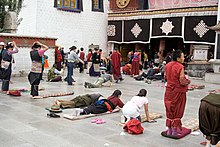
Indo-Tibetan Buddhist prostration practice at
Jokhang, Tibet.
According to Harvey, most forms of Buddhism "consider
saddhā (Skt
śraddhā), ‘trustful confidence’ or ‘faith’, as a quality which must be balanced by wisdom, and as a preparation for, or accompaniment of, meditation."
[390] Because of this devotion (Skt. bhakti; Pali: bhatti) is an important part of the practice of most Buddhists.
Devotional practices include ritual prayer, prostration, offerings, pilgrimage, and chanting. Buddhist devotion is usually focused on some object, image or location that is seen as holy or spiritually influential. Examples of objects of devotion include paintings or statues of Buddhas and bodhisattvas, stupas, and bodhi trees.
[393] Public group chanting for devotional and ceremonial is common to all Buddhist traditions and goes back to ancient India where chanting aided in the memorization of the orally transmitted teachings.
[394] Rosaries called malas are used in all Buddhist traditions to count repeated chanting of common formulas or mantras. Chanting is thus a type of devotional group meditation which leads to tranquility and communicates the Buddhist teachings.
[395]In East Asian Pure Land Buddhism, devotion to the Buddha Amitabha is the main practice. In Nichiren Buddhism, devotion to the Lotus Sutra is the main practice. Devotional practices such as pujas have been a common practice in Theravada Buddhism, where offerings and group prayers are made to deities and particularly images of Buddha.
[396] According to Karel Werner and other scholars, devotional worship has been a significant practice in
Theravada Buddhism, and deep devotion is part of Buddhist traditions starting from the earliest days.
[397][398]Guru devotion is a central practice of Indo-Tibetan Buddhism.
[399][400] The guru is considered essential and to the Buddhist devotee, the guru is the "enlightened teacher and ritual master" in Vajrayana spiritual pursuits.
[399][401] For someone seeking Buddhahood, the guru is the Buddha, the Dharma and the Sangha, wrote the 12th-century Buddhist scholar Sadhanamala.
[401]The veneration of and obedience to teachers is also important in Theravada and Zen Buddhism.
[402]Vegetarianism and animal ethics

Vegetarian meal at Buddhist temple. East Asian Buddhism tends to promote vegetarianism.
Based on the Indian principle of
ahimsa (non-harming), the Buddha's ethics strongly condemn the harming of all sentient beings, including all animals. He thus condemned the animal sacrifice of the brahmins as well hunting, and killing animals for food.
[403] This led to various policies by Buddhist kings such as Asoka meant to protect animals, such as the establishing of 'no slaughter days' and the banning of hunting on certain circumstances.
[404]However, early Buddhist texts depict the Buddha as allowing monastics to eat meat. This seems to be because monastics begged for their food and thus were supposed to accept whatever food was offered to them.
[405] This was tempered by the rule that meat had to be "three times clean" which meant that "they had not seen, had not heard, and had no reason to suspect that the animal had been killed so that the meat could be given to them".
[406] Also, while the Buddha did not explicitly promote vegetarianism in his discourses, he did state that gaining one's livelihood from the meat trade was unethical.
[407] However, this rule was not a promotion of a specific diet, but a rule against the actual killing of animals for food.
[408] There was also a famed schism which occurred in the Buddhist community when
Devadatta attempted to make vegetarianism compulsory and the Buddha disagreed.
[406]In contrast to this, various Mahayana sutras and texts like the
Mahaparinirvana sutra,
Surangama sutra and the
Lankavatara sutra state that the Buddha promoted vegetarianism out of compassion.
[409] Indian Mahayana thinkers like Shantideva promoted the avoidance of meat.
[410] Throughout history, the issue of whether Buddhists should be vegetarian has remained a much debated topic and there is a variety of opinions on this issue among modern Buddhists.
In the East Asian Buddhism, most monastics are expected to be vegetarian, and the practice is seen as very virtuous and it is taken up by some devout laypersons. Most Theravadins in
Sri Lanka and
Southeast Asia do not practice vegetarianism and eat whatever is offered by the lay community, who are mostly also not vegetarians. But there are exceptions, some monks choose to be vegetarian and some abbots like
Ajahn Sumedho have encouraged the lay community to donate vegetarian food to the monks.
[411] Mahasi Sayadaw meanwhile, has recommended vegetarianism as the best way to make sure one's meal is pure in three ways.
[412] Also, the new religious movement
Santi Asoke, promotes vegetarianism. According to Peter Harvey, in the Theravada world, vegetarianism is "universally admired, but little practiced."
[412] Because of the rule against killing, in many Buddhist countries, most butchers and others who work in the meat trade are non-Buddhists.
[413]Likewise, most Tibetan Buddhists have historically tended not to be vegetarian, however, there have been some strong debates and pro-vegetarian arguments by some pro-vegetarian Tibetans.
[414] Some influential figures have spoken and written in favor of vegetarianism throughout history, including well known figures like
Shabkar and the
17th Karmapa Ogyen Trinley Dorje, who has mandated vegetarianism in all his monasteries.
[415]







